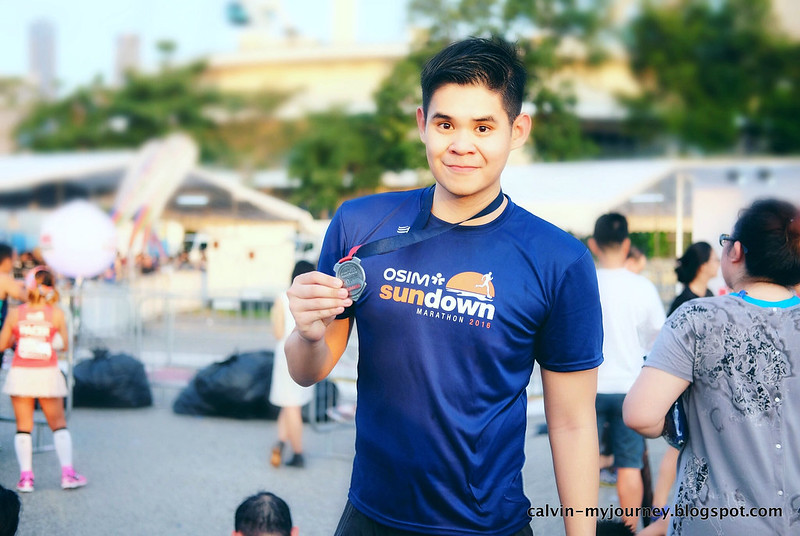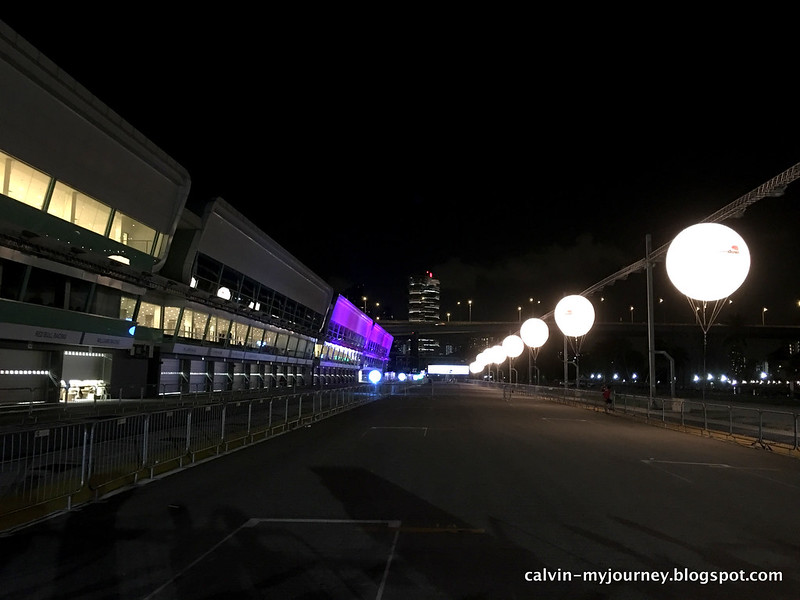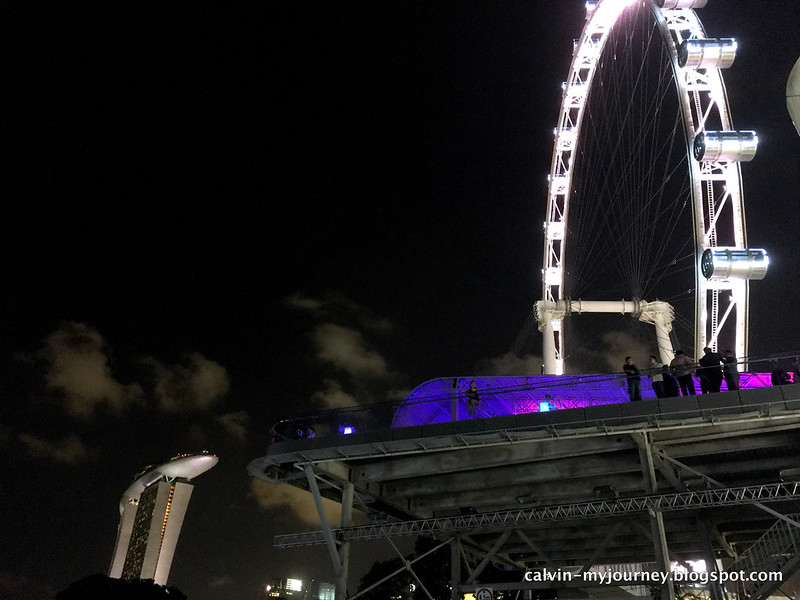"If you are losing faith in human nature,
go out and watch a marathon"
Kathrine Switzer
women's marathoning pioneer
They called it the Sundown Marathon, but I ran until the sunrise haha!
And so, my craziness brought me to my forth full marathon - OSIM Sundown Marathon 2016. The thought of doing a full marathon has been kicking into myself for some time; sort of an item to click off from your bucket list. In 2012, I took part in my very first race - the Chiba Aqualine Marathon. That was my maiden experience running in a race, and what a way to kick it off by doing a full marathon. Till now, I don't know what made me signed up for that hahaha! Believe it or not, the time I recorded back then - 5 hours 34 minutes 35 seconds still remain my personal best.
Two more runs followed after that - the 2014 edition of the Chiba Aqualine Marathon and the Standard Chartered Marathon Singapore (SCMS 2015) last year. The former was a forgettable one, as I missed the cut-off time midway through the race and did not able to complete the run. I must say however, the time limit for marathons in Japan are stricter, usually they are between 6 to 6.5 hours.
That bad experience did not stop my pursue for more runs. Last year, I ran a marathon for the first time in Singapore and phewwww it was pure torturous, especially when you think of running under the blazing tropical sun at noon without much shades. Nevertheless, I'm glad I managed to complete the run just outside the 6-hour mark.
One main reason of me signing up for Sundown was because it's held at night. Yes, it sounds interesting to run under the dark sky isn't it? I wasn't sure how my body is going to react; whether or not my biological clock will be confused middle of the run, when I should be on my bed counting the sheep lol! Plus, I did not clock up a single night runs on the build-up to the marathon. All these unknown add-ups actually made it intriguing and I was really looking forward to having a good run.
The calm before the storm.
The flag-off for the full marathon is at 12:30 a.m. and I made myself arrive at the venue just before 11. I had a short walk around the sports village and dropped by at the hydration station to gulp several cups of 100 Plus to keep myself hydrated in the humid running condition. Once I was done going around the place, I dropped my belongings at the bag deposit counter and spend a good fifteen minutes doing pre-run warm-up and stretches. The bee-line to the starting pen has started to form by this time. As I came out from the toilet break, I found out that it's just about 20 minutes before the flag-off and I made my way to the starting pen.
Thirty minutes into the midnight, more than 5,000 runners for the full-marathon were flag-off, starting our very long journey ahead. The first kilometre was really crowded, as everyone was full of energy and adrenaline. In fact, I even saw some were sprinting already. What were they thinking? This is a 42.195 kilometre run, not a 100-meter dash lol! I started off rather conservatively, maintaining my pace until...
To my horror, when I saw the first climb of the course - the almost 1-km climb up to Shears Bridge. I didn't really do the homework of studying the race course; I only browse through the map, to roughly get a general idea of how the race course will be. But definitely not this one. Nevertheless, I did not stop my run; I slowed my pace slightly during this climb.
At around the 6km mark, we entered the major stretch of the course - the East Coast Park (ECP). I was expecting that the sea breeze from the sea will do us favour during our run, but unfortunately there were minimal wind that night. To be honest, I'm not a big fan of this long stretch as you have to keep focussed on going straight along the mostly narrow paths. The ECP stretch this time was way longer than SCMS 2015. I was constantly asking myself when were we going to make that U-turn to return to the CBD.
The condition began to feel more and more humid, as the race wore on. By this time, everyone's motivation turned to the hydration stations. More runners started to have random pit-stops behind the bushes to answer the call of nature.
Mid-way through the ECP, I started to felt nauseous and my stomach was not feeling good - something between taking some wrong food pre-run. Not a pleasant sign, I told myself, especially when I have another half of the total distance ahead of me. I was still running at a considerably pace up to this point that I thought, maybe, maybe that I can get a sub-6 timing this time. However, it was around this time that the 5-hour pacers from Team FatBird overtook me. Considering my poor body condition, I did not want to take risk, and decided to play safe and maintain my momentum instead of chasing over the pacers group.
It was like a game between cat and mouse; as I alternated small runs and walking from this point onward. The banana and energy gel station came later than I anticipated, nevertheless I was glad it came as I started to feel hungry. When you have been running for such a long distance, you will feel that you body is telling you that are glycogen-depleted. And when that happens, dizziness and pain will start to kick in. The best counter-measure is to fuel consistently before you reach that stage. And to stop at every water station to make sure you don't get dehydrated.
After several kilometres under such condition, and having the 5.5-hour pacers overtook me during this painful period, I started to feel better, to my relief. We exited the ECP around the 30-kilometer mark. While people would usually hit the wall by this time, my strategy when running a full marathon was to keep a commendable pace at the first half, conserve some energy at the middle part and increase my pace towards the end. It works most of the time for me. It gives you a hero-like feeling when you are running pass people who are walking like zombies when you reach this stage of the run. The scene is just like a sea of walking dead lol!
Beautiful night view to compensate the sweat and blood (literally) endured throughout the journey.
My two most memorable scenes from the marathon this time came in the final 5 kilometre of the race. First was the pleasant surprise of a group wearing bright green t-shirts at the entrance of the Marina Barrage bridge, who offered not only food and drinks, but energetic cheerleaders to fuel and motivate the runners. I later found out that they are the Kikikukiki (K5) Runners. The lychee jelly that I managed to grab from them was one of the best I've ever tasted. A big thank you to all who volunteered at the booth.
When my spirit was lifted after leaving the group, it took a 180-degree turn the next moment. We were made to run through the infamous Marina Barrage slope. "Like seriously??!" I said out in shock, that the runner next to me overheard and looked to me haha! It was indeed a big ask for all of us to run up this killer stretch when our legs are already under such pain. Most people, including myself decided to walk up around the loop to conserve whatever energy remaining in us for the final few kilometres.
However, during our run along the Gardens By The Bay, I heard someone was whistling from behind. I thought it was the 6-hour pacers, and thought I may be overtaken by them eventually. But no, it was some random runner, who whistled and kept telling everyone stuff like "don't walk, keep running!" and "don't walk, lets make small runs until 40!" It indeed worked wonders, and I tried my best not to stop and continued to run, no matter how slow it was.
It was nothing more than a series of arguments between the part of your brain that wants to stop and the part that wants to keep going. I made sure the latter had the last words. The pain is just temporary, my body is in control, and I told my legs to shut up. I know I will be kicking at myself for not clocking a better time at the end of the run for not pushing myself to the limit.
It was another couple of kilometres until the finishing line and my body felt quite good. A quick check at the time with one of the volunteers and I knew my target of achieving a sub-6 time was possible. That's the time to give all out. But there's one final climb - the Bayfront Bridge. Right immediately after I got to the highest point of the bridge, I started my final push.
Soon afterwards, I saw the signboard written with "LAST 500 METERS". It was this moment that I know, the long journey was finally coming to an end. I started my dash when I saw the glimpse of the finishing arch looking right in front of me. Towards the last 200 meters, I sprinted so fast that everyone must have thought I've turned nuts hahaha! Crossed the line with a my right fist punching up the air, it was mission accomplished.
Like Meb Keflezighi, the U.S. Olympic marathoner once said, "Like the marathon, life can sometimes be difficult, challenging and present obstacles, however if you believe in your dreams and never ever give up, things will turn out for the best."
This is where the long journey will come to an end.
I quickly moved to one corner to catch my breather, before collecting my medals and finisher t-shirt, as well as a banana and ice-cold 100 Plus. I requested for two cans and the staff was kind enough to gave to me. The walk to the bag deposit counter, though it was less than 200 meters, felt like 200 kilometres. The aching and muscle pain was bad. Looking around, everyone was walking like penguins, so I was not that weird after all haha! I had to slowly pull myself, one step at a time, until I got to the deposit counter to retrieve my bag.
All in all, running a night race for the first time is an unique experience. Though the weather is hot and humid, with some killer climbs and sharp turns, the garden-like beauty and nice scenery managed to distract and take away the pain and cramps from the runners. And of course, the magnificent cheers from the enthusiastic volunteers who continued to cheer for the runners all night. I'm not sure where they got all their energy from at the wee hours of the morning, but those guys were simply amazing. Also, not forgetting the lady in white t-shirt at the ECP who cheered for us. She was standing there alone, but I cannot forget her genuine smile while gesturing us to keep going. I actually saw her again after the U-turn on our way back to the CBD area.
The locations of the hydration stations was not bad, and ice-cold 100 Plus was available at most of these hydration joints to quench our thirst as well as to cold down our body. It was one of the thing that actually kept me going haha! Nevertheless, I am sure most runners would appreciate that the frequency is increased towards the second half of the race.
Another full marathon completed, already looking forward to the next one!
Few improvements from my race this time is, my muscle pain isn't that bad. I still remember clearly upon completing my first marathon, I could hardly walk. Even taking the staircase requires me to hold onto the handrail. Worse than the elderly lol! And no black toenails this time, and minimal blisters. However, I had some chaffing around my armpit and thigh area, which is something new. I had my compression tights on, but those chaffing still happened. Some post-mortem to be done there I guess lol! And of course, to train properly for my next marathon because the longest run I had done prior to this race was about 10 kilometres (like only once? lol!)
Once I got home, most people would have just grab a shower and head to the bed. And what did I do? Showered and head straight to work. Not bad eh?












